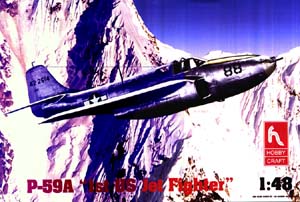HOBBYCRAFT/CANADA 1/48 P-59A AIRACOMET
Kit no. HC 1439
MSRP: $28.00
|
 |
HISTORY
Details of the development of the turbo-jet engine in the U.K., stemming
from the work of Frank (later Sir Frank) Whittle, were transferred as
routine to the United States as part of an agreed interchange of technological
progress. In the USA, the General Electric Company, was chosen to proceed
with the development of national aircraft gas turbines based on the
Whittle engine.
Because of the Bell Aircraft Corporation's geographical location,
in relation to the General Electric plant, this company was chosen to
design and build a fighter aircraft to be powered by the first American-built
gas turbine engine.
Realising that these early engines would develop only limited thrust,
Bell elected for a twin-engine installation on its Bell Model 27, with
one engine carried on each side of the fuselage. The configuration selected
was that of a mid-wing monoplane, and wide span main landing gear units
were mounted under the wings. These were well outboard of the engines
and retracted inward into the wing. The nose-wheel unit retracted aft
into the nose cone. In other respects the design was conventional, with
care taken to ensure a fairly high tailplane position so that it would
be clear of the efflux from the turbojets.
The first XP-59A, powered by two 567 kg. (1,250 lb.) thrust General
Electric Type I-A turbojets, was flown for the first time from Murdoc
Dry Lake on October 1st, 1942. Two more XP-59As were built, followed
by a batch of 13 of the pre-production YP-59A for test and evaluation.
The majority of these later aircraft, delivered during 1944, were
each powered by two 748 kg. (1,650 lb.) thrust General Electric I-16
(later J31) turbojets. The 20 P-59A and 30 P-59B Airacomets which followed
had J31-GE-3 and J31-GE-5 engines respectively, the P-59Bs also having
increased fuel capacity.
Flown for test and evaluation by the USAAF's 412th Fighter Group,
a specially formed trials unit, the P-59 was found to have inadequate
performance and proved to be an indifferent gun platform. As a result,
no further examples were ever built.
Service Airacomets had a shorter fin than the prototypes, and incorporated
the raised canopy of the YP-59s . At least one aircraft served with
the USAAF on drone control operations, fitted with nose armament and
drop tanks, it had an open cockpit in the nose to seat a drone operator.
It carried the nose art "Mystic Mistress".
WHAT'S IN THE BOX?:
The kit comes in an end-opening type box. The box art shows a P-59
in a bare metal paint scheme flying over a snow covered mountainous
landscape. The back of the box gives 4 and 5 view paintings of the two
paint schemes for the markings provided on the decal sheet.
Inside the kit are five cello bags, holding each of the four light
gray colored parts trees, the instruction folder and the decals.
The instructions is a single sheet, that bi-folds out into six pages.
Page one begins with a black and white copy of the box art, followed
by a list of kit features, then a paint color listing, and finally the
assembly symbol translations. Pages 2 through 6 give us the 11 assembly
steps.
Tree letter A holds the two halves of the forward fuselage, the engine
cowling bottom halves, and the forward horizontal tail pieces (5 parts)
Tree letter B holds instrument panel, cockpit seat, nosewheel well,
cockpit floor, landing gear doors and struts, joy-stick, turbojet tail
cones, antennae masts etc. (27 parts)
Tree letter C holds the rear fuselage parts, the gun barrels, and
the wing tips (8 parts)
Lettering now jumps to letter F tree. It holds the wing flaps, wheel
hubs, and tailplane flaps (9 parts)
Tree letter G holds the two upper wing halves and a single piece
for the lower wing halves that spans the whole distance. A great way
to get the dihedral correct!
Finally is the decal sheet. It holds three different schemes.
A P-59 serving with the USAAF in Alaska, 1944, with the nose art
"Smokey Stover" A P-59 serving with the USAAF in California, 1948 A
P-59 serving with the US Navy, NATC Pax River
The first two paint schemes are bare metal and do not tell us what
outfits these belonged to. The Navy one gets painted with a gloss dark
blue fuselage and bright orange wings.
The decal sheet includes instrument faces for the instrument panel.
Conclusion
I have always wanted a kit of the P-59, because it is the one that
got us off into the jet age. Now, here it is, and with a little extra
detailing in the cockpit should make up nice. That is its only weak
area, with just a floorboard, seat, joystick and instrument panel. Some
seat belts, at least, are needed and perhaps some other consoles etc.
However, I am not at all familiar with what was really in there.
This looks like an easy build. Well within the talents of the average
model aircraft modeler. Highly recommended.
I got my example at the local hobby shop.
By the way, Hobbycraft also sells the P-59, in another boxing as
the YP-59 version.
| 








|